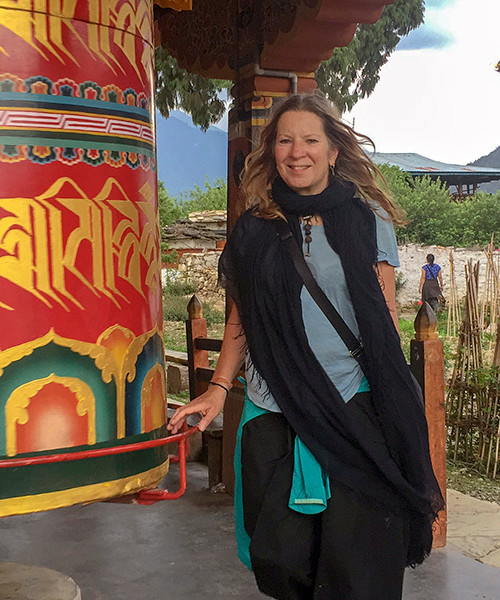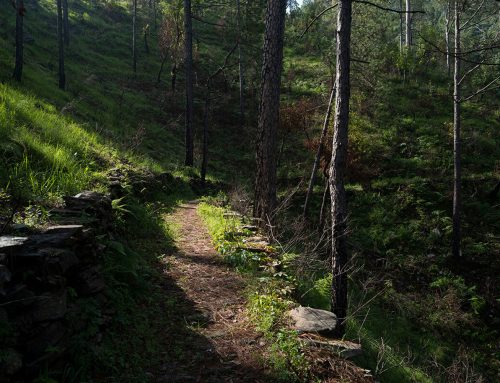Insects, Madness and Death
I’ve taught yoga retreats around the world for more than a decade taking people to India, Nepal, Sri Lanka, Thailand, Morocco and Europe.

Many people think that it’s easy to just go on a ‘yoga holiday,’ for the student and teacher alike, and usually it is. Yoga venues are exquisitely designed to connect you with the serenity of nature, with studios perched on the edge of the sea or somewhere with a divine view. They offer the healthiest and tastiest vegetarian food in the world. Yet, occasionally, even if the venue has excellent food, a proper yoga shala with decent kit, and hosts who are interested in hospitality (a tall order for many retreats), people can still be unhappy and things can go awry. At times, I’ve been out of my depth, plummeting towards fear and loathing, and muddling through challenging situations to make things right. So, what can go wrong on these ‘blissful’ yoga holidays? Plenty.
The logistics of producing a retreat require excellent organisational skills, and even if I make painstaking efforts to keep track of payments and bookings, arrivals and departures, sometimes the host overlooks essential details. The owner might be more interested in hanging out with beautiful yoginis on the beach than actually managing the place. Once, a venue accidently oversold my room allocation and a student had to sleep in a basic beach hut, rather than a luxury condo. I chose the wrong student to do this, even though she had extensive travel experience. The owner didn’t give a damn, was actually rude to the guest, and despite my offer to give her money back, and other students offering her their room, she was stuck in ‘victim’ mode, even though she liked the yoga. In most situations, if you integrate yoga philosophy into the teachings clarity will emerge. I pointed out that she had a ‘choice’ about how to react to the situation. She didn’t have to be angry and upset. It was up to her now, to either choose to have a good time by getting over her desire for things to be different, or remain unhappy and ruin her vacation. Fortunately, she was smart enough to put the yoga philosophy into practice.
Retreat owners have expected me to teach their hung-over friends ‘gentle yoga’ even though my students were intermediate practitioners who’d paid a lot of money to study Astanga. Once, a chef got into an interminable sulk when I suggested that after yoga practice when people are really hungry, a buffet is more suitable than an elaborate 3-course meal with long intervals. Or worse, one venue had no chef at all and I had to find vegetarian food in fois gras country. Fortunately, we had some excellent day trips in the south of France.
But by comparison with everything else you do on a retreat,
the actual ‘teaching’ part is joyful and easy.
Usually on yoga retreats, the level of yoga experience will range from total beginners to teachers, and it can be difficult to keep people both safe and challenged. Even if you teach a multi-level class with evolving asanas, some beginners aren’t happy to stay in the easier version. You can set them up in an alternate pose, and give what you think are clear instructions, but often they try to do copy the more advanced. They compare themselves with others, feel like loser yogis, and complain that the class was too difficult. It amazes me that people expect to do advanced asana in the first class, and if they can’t, decide that yoga isn’t for them – they don’t have the ‘flexibility’ necessary – even if you tell them that it takes decades of patience and discipline. But by comparison with everything else you have to do on a retreat, the actual ‘teaching’ part is easy.
Human behavior can be challenging, especially when people are in a foreign country. One of the reasons I like to travel is to experience a new way of being in the world and leave my cultural trappings behind, even if that means getting out of my comfort zone. Not everyone is willing to do this. People are creatures of habit, yet the yoga path demands that we change our habitual patterns. Some like to take their comfort with them wherever they go, and if things are not what they thought it would be, the corrosive energy of ‘discontentment,’ can arise and diminish the happiness of the entire group.
[metaslider id=3040]
The best antidote to discontentment I’ve found so far is to try to get people to appreciate the present moment. Reality as it is. This is my mantra. I teach the concept of Santosha (contentment), the second Niyama of Patanjali’s 8-limbed path. Is the glass half empty, or half full? It’s about perception. We get good at what we practice, and if discontentment is the practice of choice, then we become excellent moaners and will have few friends, except those who like drama and manipulation. Gratitude leads to contentment, and only after Santosha has taken root will true happiness and joy arise. Some people get this, but, in others, the mind is very strong and old patterns persist. Even if there are problems that can’t be solved on a retreat, it seems sensible that we should try to make the best of the situation.
Whether it’s a ‘yoga holiday’ or a proper yoga retreat/workshop or intensive, if you teach ‘real’ yoga, at some point, discomfort inevitably arises and you have to deal with it. People will have happy days and sad days. I know from experience that when I learned to breathe properly uncomfortable emotions surfaced. Unpleasant sensations have arisen when I’m pressed up against myself in an asana, knowing that I’m really confronting my own mind. Only after years of practice can you remain ‘neutral,’ and not feed either the aversion or the pleasure, and let the alchemical process of yoga dissolve the discomfort. So, we need to know that students, too, will go through this process, and it can be quite difficult, depending on how they feel about themself.
If a student does get ‘upset,’ or has a vulnerable day, you need to create a safe space so they can experience what they’re feeling. If it happens in the yoga class, one of the best ways to calm them down is to put the student in Paschimottanasa, cover her with a blanket so she feels safe, and let her know that it’s ok, all emotions are allowed, and to just breath and sit with the discomfort until it passes. Occasionally, a peer will rush over to her, hug her and try to soothe her under the guise of compassion, yet this only makes the situation worse. It actually robs her of the participant of the transformative experience to do the internal work necessary to shift the causes of her own suffering. This is a case of mistaking compassion for empathy.

Some people are depressed, bi-polar, or have ADHD or Asperger’s, they’re taking meds, experience high anxiety or stress, and have difficult and complicated lives. The average demographic on my retreats is single women in their late 30s or early 40s, who’ve just left a relationship or quit their job, and want to find true meaning their lives. (And, unrealistically expect this to happen in one week.) A few will project ridiculous notions of guru-status upon you (although I discourage this). People really think a yoga retreat is a place, time out of time, where magic will happen. Most come expecting a certain amount of cathartic experience. But, if you teach long enough, chances are that you will encounter mental illness. Very few people will admit to being sick. And, it’s difficult to know how bad the situation really is or what to do. Most of us are not trained doctors, or psychotherapists, yet we still need to deal with what can be a terrifying, and dangerous, situation. It’s our responsibility to keep people safe. As yoga teachers, are we ever truly prepared to deal with serious mental illness?
As yoga teachers, are we ever truly prepared to deal with serious mental health issues?
Humans are messy creatures, flawed and vulnerable, at that is part of our beauty. One of the most important lessons I’ve learned is the need to create a safe space to process whatever is going on. You might think this is ridiculous, like some bogus new-agey goop, but it’s actually ancient wisdom. One of my main tools is hosting a Native American talking stick circle. It truly creates a heightened, almost ritualistic, space where people feel they can be real and share the process they’re experiencing. It allows them to analyse their reactions to things and builds a circle of trust for a safe transformative experience.
It’s also useful to make a genuine effort to integrate basic yoga philosophy into the asana class as it gives students structure to understand the yogic path, provides context for the practice, and guidelines to live by to diminish suffering. To understand the process participants need to know how yoga works. It can be difficult for people to see that much of our suffering is a result of our own perception, and that we actually manifest everything happening around us. 99% of the time, if you keep everyone focused on the yoga, and share the ancient wisdom techniques properly, and give them skillful means to take the practice off the mat and into their life, people will move through their impermanent discomfort and see that the yoga path really does work. For this, they are truly grateful.
Most of the above are the ‘usual’ challenges involved in running a successful yoga retreat, but sometimes things go really wrong. I once got amoebic dysentery in Goa and ended up in the hospital on a drip. I’ve had serious infections from tiny cuts. Anything can happen. One of the biggest lessons I’ve learned is that things are out of my control and if I can accept this fact, it’s easier to embrace the chaos. There can be dangerous insects and reptiles. I stepped out of my hut in Sri Lanka and a baby cobra rose up before me. Giant wasps have flown around my head and beetles have landed in my hair. Students have had full-blown psychotic meltdowns. At times, I’ve felt like I was living in a Buddhist hell realm. No matter how much I’ve tried to ‘maintain equanimity under all circumstances,’ I’ve been diminished by pure, raw, FEAR.
If we expect students to move outside their comfort zone, it’s only fair that as teachers we should too. But how do we walk the path of fearlessness? Fear is not a trivial matter. It can restrict our lives; imprison us. Fear can cause us to act irrationally and do harmful things. The root cause of our suffering is ignorance of the true nature of reality, and the craving and clinging to something illusory, like ego. Yoga retreats can be a great opportunity to explore our own fears so that we can embody a sense of selflessness, and truly be there to serve.
Here are a few examples, of how I’ve struggled with my own fear when things have gone wrong on a blissful yoga holiday.

I N S E C T S
I’m leading a retreat on an island off Thailand, just south of Myanmar. It takes about 28 hours to get here, a long flight from London to Bangkok, down to Phuket, an hour taxi ride, and a long boat ride, before reaching the island. It’s dusk as I step into my large wooden cabin. I turn on the lights and about 50 beetles fly inside. I don’t like beetles much. I’m an entophobe, someone with a phobia of flying insects. I loathe the motion of their exoskeleton, hate the clacking sound as they fly and their thudding into walls. I can’t relate to them and feel a tremendous sense of disconnection. My worst fear is that a beetle will land on my face.
When I encounter one, my mind and body feels like they’re breaking up in a spasm of inchoate movements. Adrenaline shoots up my spine, my muscles contract and my brain interprets this as ‘fright.’ (It’s not a kundalini experience.) I fear that I will lose control, go mad, flail about and injure myself, or others. Of course, this has never happened, but I have a powerful urge to escape the situation immediately. I realise that my fear is totally irrational, as beetles can’t hurt me. Bottom line: I’m totally horrified at the thought of spending a week here, in the dark with beetles. I know that projecting my fears into the future and believing that something bad will happen does not help the situation. My reaction is not yogic.
It’s a yoga retreat so I must do my best to deal with my fear. I discover that if I turn on the brighter, outside lights first, and keep the inside lights dim, a light barrier is created to deter the beetles, but I’m always on the look out and feel unsafe. I don’t have to go far. As we gather in the lounge before dinner, two beetles land in my hair. I’m helpless and feel vulnerable and struggling like everyone else. But rather than scream and run amok, I become totally still and cover my face. Everything slows down and the absence of physical movement keeps me calmer, just like it does on the yoga mat where physical stillness inspires mental stability.
A young woman about 19 years old, on her first trip abroad, is staying alone, and she too is so scared that each night the local boys have to check her hut for beetles. (I’m sure they enjoyed that part of the job!) As an antidote to fear, I teach the Tibetan Loving Kindness prayer in yoga class. “May I be filled with loving kindness. May I be well. May I be peaceful and at ease. May I be happy.” Often when we have an ‘enemy’ it’s a result of taking someone out of our heart, and placing them over ‘there’ and choosing to perceive them that way. Other people love them. So this prayer is a way of changing our perceptions and transforming destructive emotions like hatred, anger, prejudice and fear, so that our mind is less disturbed. We send loving kindness to all the beetles and creatures inhabiting this land to turn our oppressors into benign beings.
In the end, the whole experience becomes manageable, partly thanks to the light barrier at night, and the fact that we spend most of the outdoors in the day. I never did find out if this really is a ‘freak season’, and the post-Monsoon beetles a rare phenomenon. I doubt it. Ultimately, I’m grateful for the experience, but I haven’t taught another retreat here.
Words of Advice:
- If you don’t like bugs, don’t go to the jungle.
- In terms of dealing with irrational fear, try to slow down your breath and dissolve the escalating panic, keep the mind focused on the breath, and sit fiercely with everything that is happening. Try to commit to being present and not distracted by the raging external display of nature, fear and emotions. Letting go of fear is being totally present in the now.
- Projecting thoughts into the future and imagining the worst takes you out of the present moment. This is not yoga. Consider Patanjali’s notion of Citta Vritti Nirodha (Sutra 1.2) and reign in the mind from extreme fluctuations so that it will have stability.

F O O D
Food is of utmost importance on a retreat and there are plenty of options from raw food, to vegan and alkaline, to non-veg and traditional regional cuisines. Always make sure that you know what’s on the menu and make changes if necessary.
This is what happened on my first yoga retreat. We are in Ariege, a district in the south of France, near Carcassonne and the beautiful Pyrenees. The venue and yoga shala are beautiful, but there is no chef! Breakfast only. You wouldn’t think that it would be difficult to find good food in France, but if you’re a vegetarian it can be. Ariege is goose country. Fois gras is everywhere, most dishes on the menu are meat and almost every restaurant has the same menu. Other than the ubiquitous vegetarian omelet, salad and French fries, there is simply not much to eat.
By mid-week we are desperate and I find an idyllic restaurant in the guidebook. It’s situated in a forest and on a lake, and they serve fresh trout. A few people eat fish and the rest of realise the vegetarian cuisine will only get better if we cook our own food. So, we pile in the car and have leisurely four-hour drive though the mid-Pyrennes visiting exquisite medieval towns with cathedrals en route. At the end of a very long country lane is the lake house. It doesn’t have that remote Twin Peaks feel, or a 50s Hitchcockian vibe, I’m expecting. It’s another plain regional restaurant with plastic lace placemats and the fois gras menu. The waiter says, “Sorry Madame, there is no fish today.” We laugh at the absurdity of all this, order an omelet, and decide to be yogic about it all. We let the santosha (contentment) arise and comment on the irony of our grasping minds.
Words of Advice:
- People like to go out for a culinary experience. Try to visit the restaurant first or at least check out the menu.
- If you want to go to a restaurant with fresh vegetarian food, make sure you make that clear.
- It’s a personal decision whether you want to be a vegetarian or not, and usually its best to leave it up to the individual to decide. While you can explain the ethical problems involved by supporting the meat industry, I’m not convinced that it’s our job to take people into an actual slaughterhouse. Sometimes giving them the information is enough
Once, while teaching a retreat in Italy, a place renowned for good food and innovative vegetarian cuisine, we end up in a restaurant that is best described as a slaughterhouse. It’s a popular spot in the hills north of Rome and is frequented by locals. I usually like to take people out for dinner to experience authentic regional cuisine. We arrive, six women and one man, and are the only people here. Never a good sign. I hope we’re just early. Deep-fried seafood appetisers arrive and my spider sense tells me it was a mistake. A TV in the corner is playing some violent program of people being shot up and killed, not what you want to watch while eating dinner. Bottles of red wine are emptied.
I discover that I’m sitting beside the grill and the chef starts shaving Carpaccio from a pig’s cheek. And then hacks into the animal with his machete and throws the flesh on to the grill. Suddenly, the whole place feels like an inferno and I descend into a hell realm. I’m nauseous. The slaughter and violence is just too much. I stagger outside and vomit. My 80-year-old mother is on the retreat, and the owner has just finished a juice fast, so they’re easily persuaded to leave. The others remain as they’re having a good time.
I ask the retreat owner why he recommended this restaurant, and only get a vague answer that it’s popular. For me, this choice of restaurant was inappropriate and actually undermined my discussion of Yoga Sutras and concepts like Ahimsa (non-harming) in yoga class. Of course, the students could have cared less. The question of vegetarianism is always contentious. Although I personally haven’t eaten meat for 35 years, I’m not a hardline vegan. I’m immensely grateful to those Jivamukti yogis who really walk the walk, and while I do explain the costs to the planet and the suffering inflicted on sentient beings by supporting the meat industry, I let people decide what they eat. Many people who come on yoga retreats are not vegetarians (and neither were they during the Vedic age), yet most are pleasantly surprised to discover that after a week of eating gourmet vegetarian cuisine that they’re still alive and actually feel amazing. My bottom line is: I don’t want to be responsible for slaughtering animals in the name of yoga.
Words of Advice:
- Try to visit the yoga venue before you run the retreat. If you can’t, then find out about its reputation from credible sources.
- Food is very important. Make sure you find out what’s on the menu. It’s helpful is the chef is flexible and willing to prepare food for people with various allergies and dietary needs.
- Don’t hire a venue ‘sans chef,’ unless you know that there are good restaurants close by, or bring your own chef.

Varanasi, India
D E A T H
Death is inevitable and while yoga can help us to deal with our own mortality, it’s not something you expect to experience on a yoga retreat. I’m hanging out in an exquisite spot in Kerala after teaching on a yoga retreat. The yoga shala overlooks the Arabian Sea and is one of my favourite in the world. Once, while doing a headstand, I spotted a dolphin in my dristi gaze. Sublime! Anyway, a local Hindu women dies during the night and it turns out that the yoga venue is actually built on the cremation grounds. The locals tell us that they will administer the last rights in the morning. We think this could be quite shocking for the new arrivals, especially for those who haven’t been to India before or have any experience with death, so decide to send the new arrivals to a nearby beach for the day.
The village men arrive, carrying the corpse through the yoga venue to the cremation grounds. An elaborate Hindu ceremony ensues and the body is lit on fire. I realise just how visible death is in India and consequently how much it’s just accepted as part of life. There is no escape from death and it can happen anywhere, any time. Actually seeing a body cremated really brings the reality of death closer to home. (I once made a special trip to Varanasi to experience death at Manikarnika Ghat.) We’re respectful and keep out of the way wanting to maintain a good relationship with the locals. I think it would have been insensitive for yoga students (and for the family) to be sitting on their balconies gaping at a cremation on their first day in India! Even though some students would be totally OK with the experience, others might be upset and you need to be prepared to deal with the consequences.
While the cremation fire smoulders, god knows why, a tourist mistakes it for a BBQ!
To make matters more bizarre, later on that afternoon, while the fire is still burning, god knows why, but some tourists mistake it for a BBQ and starting grilling meat. They think they’ve got lucky! Can you believe it? I’m still stunned. The owner explains what’s really going on and points to the hips of the women smoldering among the ashes. Aghast, they leap backwards, run off, and retch their way down the beach. This is the worst case of misconception of reality I’ve ever encountered.

Another brush with death occurs in Thailand. We’re on an exquisite island in pristine nature, but it was hit hard by the 2004 Tsunami and the residue is everywhere. Giant uprooted trees are strewn along the beach. White washed they look like silent monuments and are constant reminder of tragedy that happened here. Many people died. We spend afternoons on the beach, sitting in deep reflection, listening to the intense surf, our breath and observing the mind. There is an inescapable lingering sadness everywhere. No one feels that this is a light ‘yoga holiday.’
One of my students receives the sad news that his mother has passed away and he decides to leave the retreat. My own father died earlier this year and so I’m able to relate to what he’s going through and try to comfort him. Someone told me once that mothers rarely die in front of their sons, and whether this is true or not, I pass it on hoping that it will diminish his guilt for not being with her at the end. If this happens to someone on a retreat, it’s important to be genuinely concerned and acknowledge what’s happened. I listen and allow him to express his feelings without much comment. While the yogic path is designed to help us become fearless in the face of death, I don’t feel that it’s necessary to share it; nor point out the certainty of death. He has too much on this mind. I support him in his decision to leave the retreat and suggest that he allow himself to experience all the emotions washing over him without judgment. Sometimes it’s enough just to be present and kind. So, you might be in a beautiful place, but disturbing things can still happen.
Words of Advice:
- Sometimes it’s good to shelter people from unpleasant sites that could disturb their mind. If you don’t, be prepared to deal with the fall out.
- Know your group. If this were a yoga teacher training or serious yoga retreat and not just a ‘yoga holiday,’ then it would be appropriate to watch a cremation with approval from the family. I’m still grateful to Richard Freeman who took us into a morgue as part of the Anatomy section on his yoga teacher training.
- Know that death is inevitable and it will happen to all of us. The Buddha says that everyone you’ve ever loved will eventually die. You will die. This is reality and the root of our suffering is our clinging and attachment to life. Many Buddhist teachings ask that we mediate on our own death to get used to the idea. Some tantric yoga practices actually in involve eating out of a skull bowl and sitting on a corpse for mediation to overcome our aversions to things. (Obviously, these practices are for very advanced yogis.) While from a tantric perspective we might need to subdue our fears around death, the reality of the situation is still very challenging for ordinary people.
- Set up a safe space where people can process whatever is going on. At the very least, be authentic and genuinely present with people who are going through difficult times. Sometimes you don’t need to say anything, just your presence is enough. Compassion will arise.





